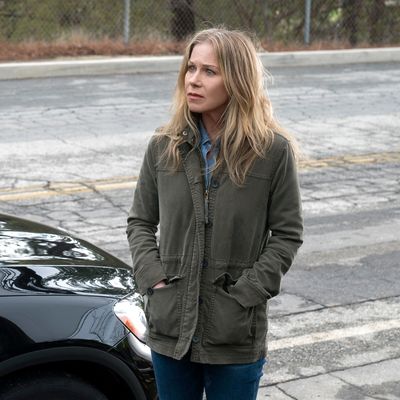
Minute to minute, inside the space of each scene, the new Netflix series Dead to Me works. On a micro scale it’s almost unimpeachably constructed. The leads, Christina Applegate and Linda Cardellini, are both fantastic as two women who meet each other in a grief-counseling group and grow to become intimately close friends. The world Judy (Cardellini) and Jen (Applegate) live in is also perfectly designed when viewed from a narrow angle. Each room in their glossy, massive homes makes sense on its own. The shots of them sitting next to a pool or huddling together on a beach or leaning over a monumental kitchen island, wine glasses in hand — in those moments, you feel like you know who these women are, and you know what kind of show Dead to Me is.
As a whole first season, though, those pieces add up to something a little uncanny, a series that feels both highly considered and also weirdly underbaked. I can point to individual scenes and say, “This show is a thriller” (dramatic flashbacks! Exciting cliffhangers!), or, “This show is a comedy” (goofy, shrill mother-in-law! Drunken escapades at a bereavement event!). I can also say, “This show is making fun of itself” (James Marsden’s glorious over-the-top oiliness as Cardellini’s ex), or, “This show takes these women seriously” (several touching moments in their friendship). But I don’t know how to add all of those things together into a clear, consistent picture of Dead to Me’s tone or its world.
It is very watchable, in spite of that unevenness. There’s no denying that; Dead to Me feels carefully calibrated to make you click on the next episode as quickly as possible, and the experience of watching it feels as smooth and frictionless as one of the show’s many highly polished architectural surfaces. From one perspective, that smoothness is a good thing. Especially within the first half of the season, there’s nothing about Dead to Me that leaps out of its context, that feels distracting or out of place.
But that smoothness is also the result of how derivative it feels. It’s as if someone carefully found the exact average of Big Little Lies, The Affair, Revenge, Desperate Housewives, Damages, and How to Get Away With Murder; took that result and plumped it up with a Netflix drama budget and slightly too long run time; and sent it off into the world with some stellar leads and a great location scout. It goes down smoothly because it feels designed for a market that Netflix already knows exists. You can almost see boxes next to various Netflix taste clusters getting ticked with each new scene. Murder, secrets, excessively luxurious California real estate, complicated female leads, plot misdirection, a sassy gay partner, wine glasses, cynicism, and sadness — check, check, check, check, check. Dead to Me feels like content made into the shape of a TV show.
The second half of the show’s ten-episode season is unquestionably messier than the first, although to elaborate on why that is, or the plots that pull it in that direction, would necessitate major spoilers. But the longer I’ve thought about the season as a whole, the more I think about that latter half of the show. Many of Dead to Me’s biggest twists happen right up front, and arguably the second half is not twisty enough, and does not live up to the expectation-defying premise of the show’s earlier episodes. It settles into a status quo, which is something a show designed as a thriller should probably not have. The second half of Dead to Me also introduces several underserved characters and minor plot threads, which include a nice cop, a sudden unpersuasive financial pressure, a story about Jen’s son who wants to be a performer, a character played by Ed Asner who seems to have been cast as himself, and most strangely, an elaborate dance routine that happens for no reason at all, and after one lampshading comment, is never referred to again.
Everything slows down and gets slightly weirder in the second half of Dead to Me, and probably by any reasonable standard, that should be considered the weakest part of the show. And yet, the moments of Dead to Me that feel the most unforced and the most inexplicable also stick with me more successfully than any of the earlier storytelling-by-algorithm sequences. Why, why does Christina Applegate’s Jen perform an entire Fosse-esque dance routine with the obvious polish of a professional dancer, something that makes no sense for the character Dead to Me has been developing thus far? Are we supposed to sympathize with her when her business partner tries to dump her, or are we supposed to think she’s crossed a line? What happens to the story where Jen’s elder son starts selling drugs?
These are probably plot holes or inconsistencies, or more generously, bits of plot and character that might be developed further if Dead to Me gets a second season. Within this first season, though, their weird incompleteness perversely highlights how much Dead to Me benefits from its few moments of memorable strangeness. Christina Applegate’s dance number has no business being in this series, but its presence is one of the few things that makes Dead to Me feel like it was made by people rather than the mathematical averages of several audience-tested subgenres. When I consider Dead to Me’s first season as a whole, the details of the thriller plot carry very little weight. The things I remember most are the two great lead performances by Applegate and Cardellini, James Marsden’s very persuasive role as a charming dirtbag, and how much I wish the whole series embraced its kookier impulses.


